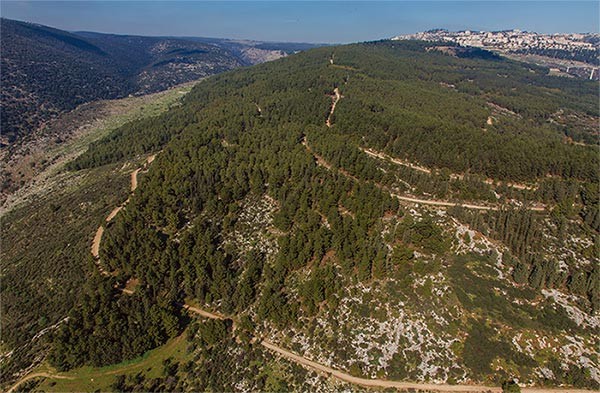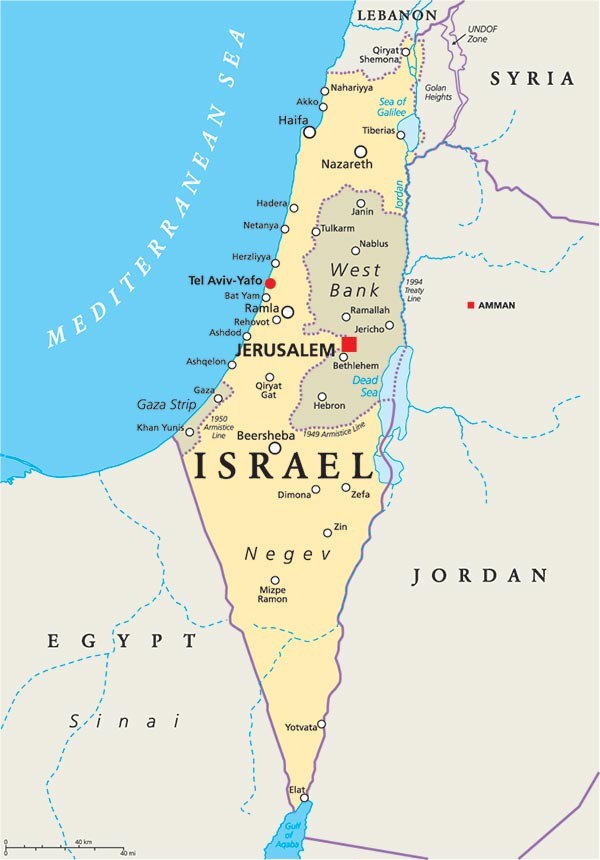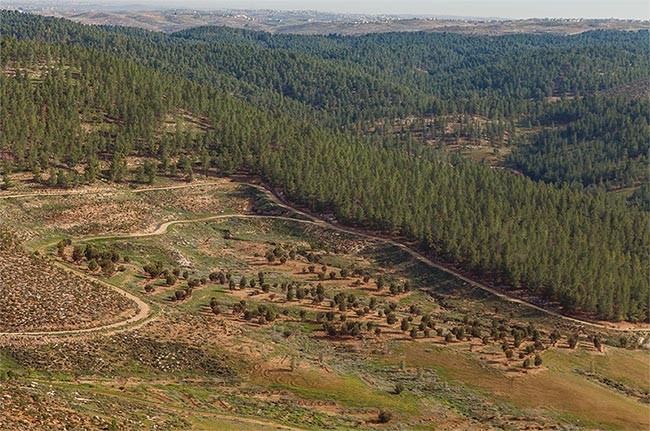I’ve traveled to Israel many times, but on my most recent trip, I found the forested hills between Tel Aviv and Jerusalem more awe-inspiring than ever. The hills are blanketed in tall pines, offering a rich, green vista in every direction.
This would not be particularly impressive in New England, where forests are nature’s default state; but here it was astonishing, because every one of these hundreds of thousands of trees was planted by hand in an area that averages less than 13 inches of rain a year. Vermont, by comparison, averages almost 37 inches.
With 240 million trees planted, and with a fifth of the land area committed to conservation, Israel is one of very few countries where there’s been a significant net gain in trees in the recent past. And even though it contains only a minuscule fraction of the planet’s wooded areas (the country is smaller than New Jersey), the trials, errors, and triumphs experienced here hold lessons for a hotter, drier, and less forested world.
Originally from Europe, the country’s early leaders aspired to turn their new homeland of bare, deserted hills into a green oasis. The Keren Kayemeth LeIsrael (Jewish National Fund), a non-profit Zionist organization with close ties to the Israeli government, was responsible for much of the afforestation of the region. Trees were planted to protect public land, provide employment, and encourage settlement. Trees also became political facts on the ground, signifying permanence and control.
“We can’t make lakes flow into our barren country,” noted David Ben Gurion, Israel’s first prime minister. “But there’s no reason why our country cannot be covered with forests in every place possible . . . and there is no place where it isn’t possible.”
Massive planting initiatives began in the 1960s, but many of the area’s Arab populations were proud of the region’s agricultural history, primarily the sheep, goats, and olive trees that could be raised in the harsh landscape. They were also suspicious of colonial British and Zionist intentions, equating trees with soldiers, a view still in evidence a century later. The politics of trees was exacerbated after Israel’s 1948 War of Independence, when Arab villages were razed and the land planted into forests.
Beyond the complex politics, Israel’s forestation efforts also presented logistical challenges. How do you recreate forests that may or may not have existed centuries earlier on land that Mark Twain called “the most dismal scenery on earth?”
Early efforts featured big and small mistakes. The tall conifer forests I was admiring are composed of Aleppo pine, a species selected for rapid growth and for the conifer’s ability to survive hot, dry summers. Although a native species, the trees were grown from seeds imported from France, where they’d adapted to higher humidity and richer soil. The trees were planted using heavy equipment, which trampled the thin soil and tore out all existing vegetation, followed by herbicides to suppress new undergrowth. To achieve maximum efficiency and rapid crown closure to suppress competing vegetation, the trees were planted too close together. Worse, the planted forest was a classic monoculture, making it susceptible to a single pest or disease.
The foresters had no experience growing trees in drylands: There’s the story of one devoted forester’s rushing out after a rare Jerusalem snowstorm to clear the snow off as many seedlings as his exhausted limbs allowed, only to discover that the seedlings he’d “saved” had frozen. The ones he couldn’t get to survived under a warm blanket of snow.
The learning curve was slow and steep because trees are not tomatoes; in forestry it takes decades to see what works. When the shortcomings of these particular pine forests were understood, it precipitated a sea change in policy from tree farms to sustainable, diverse forests that require minimal human intervention.
In most cases in Israel, it was pines that were chosen to play the role of pioneer species. Oaks soon began establishing themselves under the pines, suggesting a natural succession. Clearly, planting more oaks was the answer. But the slow-growing oaks couldn’t compete with the pines.
As the pines began to die and natural clearings formed, acorns were planted in the openings, resulting in a layered forest of high conifers and low, broad-leaved trees. An element of diversity, a key component of sustainable forests, had been achieved.
Truly sustainable forests, though, are able to regenerate without human intervention or investment. To achieve this, Israel’s foresters focused on introducing native species such as acacia, carob, terebinth, cypress, and other varieties of pine. Olives, almonds, dates, and grapes were included in the mix. Meanwhile, the surviving Aleppo pines continued to spread seeds and grow.
Grazing, strictly banned in the early years, is now encouraged. Second-generation forests have a dense understory that limits recreational opportunities for humans and increases the risk of fire. Grazing animals are now used in some areas to keep the forest floor open, which allows for more wildflowers – these have become an attraction for people. Polls show that Israelis enjoy the mosaic of open land, shaded forests, and low brush that doesn’t impede visibility – a landscape created, in part, through grazing. There’s still terrific resentment felt by the indigenous Bedouin towards Israeli forests and settlements, but since shepherding continues to be a way of life for the Bedouin, there’s hope that better grazing opportunities will help improve relations.
Wild animals are also finding the forests to their liking. Gazelles, jackals, foxes, hyenas, badgers, porcupines, and hare, whose numbers were decreasing, are now stabilizing. Birds like hawks have returned; pollinator numbers are up, a service much appreciated by local farmers. With time, the forests are improving soil quality, signaling a decreasing need for human intervention.
Perhaps the most important service forests provide today is as a destination for the two million Israelis – Arabs and Jews – who visit them. This represents one quarter of the country’s population, a testament to the fact that all the forests are public lands that belong to all. In a hot country – both in temperature and in political climate – the forests provide much needed respite and recreation.
Ecologists criticize the plantations in the Negev desert as “savannization;” this area’s a natural desert, and so a forest here constitutes an artificial landscape. These forests are thriving due to intensive rain harvesting methods, but endemic flora and fauna are suffering. The methods employed here raise many questions, and the research station in Yatir, the largest forest in the Negev, draws scientists from around the world.
Israeli foresters continue to experiment. Drought-resistant species are being developed using seeds collected from trees that have proven capable of surviving years of drought. Foresters have accepted that native forests will be sparser and shorter than those of temperate and tropical lands, and that the thick vegetation portrayed in the Bible may have never existed. They’re finding that despite a local tradition of planting during the rainy season, seedlings planted in autumn fare better. They’re learning that not every native species can be re-established. Mostly, they’re realizing that given Israel’s varied soil types and topography, forest management must take place on a sub-regional level.
Today, the chief enemy of forests in Israel is the increasing number of fires, some set by arsonists with political motivations. New forests are shaped to control fire damage by minimizing understory vegetation, prescribed burning, the pruning of low branches, and construction of substantial fire breaks. Burned areas are allowed to regenerate for two years before the emerging seedlings are thinned. Interestingly, forests that experience periodic fire disturbance of moderate intensity attain maximum species richness; thus, fire can have a positive effect on the forest.
Israel’s forests are a grand experiment whose successes and failures have implications for about half the planet, where the establishment of forests is seen as critical for millions of people who face water scarcity, a warming climate, and landscape degradation caused by the weather and human activity. This country known for its great challenges – a growing population desperate for land, a difficult climate, and enormous political turmoil – is attempting to rewrite old stories of forest loss into new stories of renewal.





Discussion *